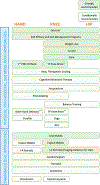2019 American College of Rheumatology/Arthritis Foundation Guideline for the Management of Osteoarthritis of the Hand, Hip, and Knee
- PMID: 31908163
- PMCID: PMC10518852
- DOI: 10.1002/art.41142
2019 American College of Rheumatology/Arthritis Foundation Guideline for the Management of Osteoarthritis of the Hand, Hip, and Knee
Erratum in
-
Error in Figure 2B of the Article by Kolasinski et al (Arthritis Rheumatol, February 2020).Arthritis Rheumatol. 2021 May;73(5):799. doi: 10.1002/art.41761. Arthritis Rheumatol. 2021. PMID: 33913629 No abstract available.
Abstract
Objective: To develop an evidence-based guideline for the comprehensive management of osteoarthritis (OA) as a collaboration between the American College of Rheumatology (ACR) and the Arthritis Foundation, updating the 2012 ACR recommendations for the management of hand, hip, and knee OA.
Methods: We identified clinically relevant population, intervention, comparator, outcomes questions and critical outcomes in OA. A Literature Review Team performed a systematic literature review to summarize evidence supporting the benefits and harms of available educational, behavioral, psychosocial, physical, mind-body, and pharmacologic therapies for OA. Grading of Recommendations Assessment, Development and Evaluation methodology was used to rate the quality of the evidence. A Voting Panel, including rheumatologists, an internist, physical and occupational therapists, and patients, achieved consensus on the recommendations.
Results: Based on the available evidence, either strong or conditional recommendations were made for or against the approaches evaluated. Strong recommendations were made for exercise, weight loss in patients with knee and/or hip OA who are overweight or obese, self-efficacy and self-management programs, tai chi, cane use, hand orthoses for first carpometacarpal (CMC) joint OA, tibiofemoral bracing for tibiofemoral knee OA, topical nonsteroidal antiinflammatory drugs (NSAIDs) for knee OA, oral NSAIDs, and intraarticular glucocorticoid injections for knee OA. Conditional recommendations were made for balance exercises, yoga, cognitive behavioral therapy, kinesiotaping for first CMC OA, orthoses for hand joints other than the first CMC joint, patellofemoral bracing for patellofemoral knee OA, acupuncture, thermal modalities, radiofrequency ablation for knee OA, topical NSAIDs, intraarticular steroid injections and chondroitin sulfate for hand OA, topical capsaicin for knee OA, acetaminophen, duloxetine, and tramadol.
Conclusion: This guideline provides direction for clinicians and patients making treatment decisions for the management of OA. Clinicians and patients should engage in shared decision-making that accounts for patients' values, preferences, and comorbidities. These recommendations should not be used to limit or deny access to therapies.
© 2020, American College of Rheumatology.
Figures


Comment in
-
New OA management guidelines.Nat Rev Rheumatol. 2020 Mar;16(3):127. doi: 10.1038/s41584-020-0378-4. Nat Rev Rheumatol. 2020. PMID: 32001825 No abstract available.
-
Osteoarthritis Management: Updated Guidelines from the American College of Rheumatology and Arthritis Foundation.Am Fam Physician. 2021 Jan 15;103(2):120-121. Am Fam Physician. 2021. PMID: 33448759 No abstract available.
References
Publication types
MeSH terms
Grants and funding
LinkOut - more resources
Full Text Sources
Other Literature Sources
Medical

